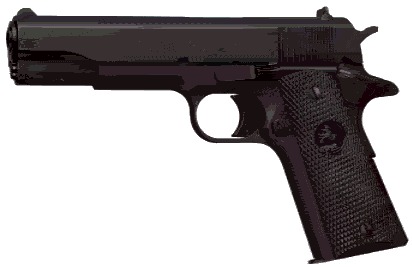
In 1905 John Browning’s original .45 automatic pistol was introduced to the world through Colt Manufacturing Company. First issued to the U.S. Army, it began to turn the tide of handgun design for years to come.
In 1911, just prior to World War I, the Model 1905 Military evolved into the Colt Model 1911A1. During WWII, companies such as Ithaca, North American Arms, Remington-Rand, Remington-UMC, Singer Sewing Machine Co., and Union Switch and Signal produced the 1911, as well as Springfield Armory, which continues to produce the 1911 today.
The 1911A1 served in the U.S. Military for over 70 years, being officially replaced by the Italian Beretta 92FS (M-9).
The 1911’s production ran until 1970. In 1991 Colt reissued the 1911 with the 1991A1 series, which even continued with the original serial numbers as it ended in 1945. The 1911 and 1991 had exactly the same specifications out of the factory. Both in .45 ACP, 7-round magazines, 5 inch barrel, 8 � inches overall, and the same sights, fixed front blade and square notch rear.
The 1991A1 is a Mil-Spec .45 ACP semi-automatic single action pistol. It has a plastic trigger, and what’s Colt calls a "service hammer" which is a non-skeletonized piece of metal used to strike the firing pin. The sights a fixed blade in the front which is, more or less, welded in, and a square notch rear sight, which is dove-tailed.
Dovetailed means the there is a groove cut out of the slide of the pistol where the sights are put. This is an easy way to change sights, and most competent gunsmiths should be able to remove the fixed front blade and cut a dovetail out for the front sight.
The 1991 is matte black, both slide and receiver. The hammer is blued and the trigger is a black plastic. Rven the grips are a black rubber. So thus, it’s all black. The magazine is, yes, black.
The pistol is single action. Thus the hammer must be cocked and the safety off to be fired. This makes the trigger pull very light, usually in the range of 5 lbs or so. An aftermarket trigger (like Wilson Combat) will take the pull down to the 2 to 3 lbs range. The stock hammer falls relatively heavy, but if you’ve never fired a Mil Spec 1911, it’s nothing that’s going to make it uncomfortable. And despite everybody talking about the need to have a Beavertail, the short grip-safety has never caused me hammer-bite.
The 1991 (series 80) have four different safeties. There is, of course, the grip safety, which is located on the back of the grip, so that when you are holding the pistol, ready to fire, it disconnects automatically. The Manual safety is located on the receiver, just below the rear of the slide. This can be activated only when the pistol is cocked. This safety, when active, engages a cam that catches on the trigger sear and disengages it, it also catches the slide, and does not allow it to move rearward. The two other safeties are the firing pin block and the disconnect safety.
The gun weighs in at 38 ounces, empty. Add the weight of seven .45 rounds and it becomes a heavy gun. Thankfully, this helps to deal with the recoil of a full power .45 ACP round and even the +P, or +P+. I’ve found this weapon much more pleasant to shoot then, say, a "lightweight" Glock 21.
The gun has included one 7-round magazine. This magazine was designed for loading Military 230 grain FMJ rounds, not the modern 185 gr. Hollow-point. To remedy this, I recommend the Wilson Combat "Bureaucrat" magazines, these feed a lot more reliably.
The 1991’s are capable of excellent 3" groups at 25 yards, usually better with the right aftermarket parts. I haven’t noticed the pistol throwing the first shot out of group, but that’s pretty pistol specific. I usually run Hydra-shoks or CCI Blazer 185 Gr. TMJ. I haven’t had any misfeeds with either of these rounds. With the heavy weight behind it, and a, good, heavy recoil spring (16+ lbs) the 1991 is capable of remarkable rapid fire drills at 7 yards.
The 1911’s have been a mainstay of the U.S. Military, Combat shooters, competitive shooters, and handgun enthusiast alike. I have yet to meet someone who owns more than one handgun and have not have one 1911.
It’s no surprise that it’s been around this long. It’s an excellent weapon, with no surprises, and anything you could ever want to replace or add to your 1911, you can. I recommend this gun to anyone.